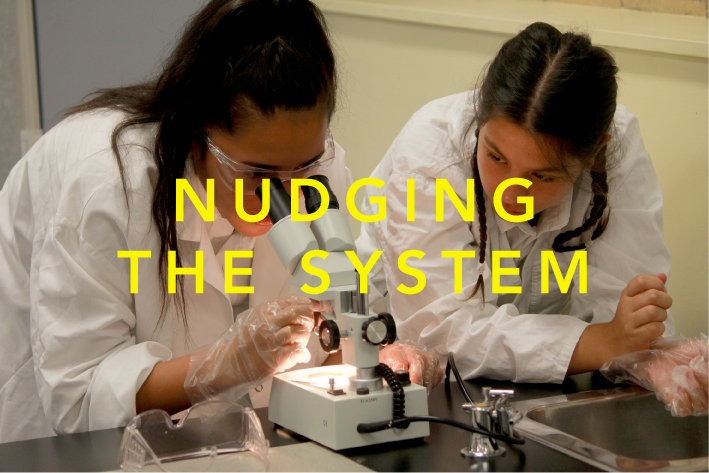
Developing innovation with impact
blog | 28 Jul 2017
In her second post, Stacey Quince, Principal at Campelltown Performing Arts High School (CPAHS), reflects on the journey her school – and her system – is taking to transform the purpose and nature of learning.
Campbelltown is a public school located in South-Western Sydney with 1100 students from diverse language, cultural and socio-economic backgrounds. You can find her first post here.
Tangible impact on learning and learners:
Our collaboration with Innovation Unit has permeated almost every corner of the school and continues to push our thinking and practice. As a result of our ongoing relationship over the past four years, we have a strong culture of innovation at CPAHS and a commitment to future-focused learning. Staff regularly using disciplined innovation methods such as prototyping to create new approaches to learning; supported by an exploration and understanding of student needs and underpinned by evaluation strategies that help us to be responsive to the evidence and adjust our practice accordingly. In a few short years, approaches that we developed when first working with Innovation Unit through the Learning Frontiers initiative back in 2013 have become common practice in our context.
Through our evaluative thinking processes, we know that this work is having an impact in a broad range of ways – increased student engagement, improved learning outcomes, enhanced partnerships with community, and stronger partnerships with parents.
Even by more traditional standards we are improving. Year 9 NAPLAN growth continues to increase; the gap between our Aboriginal students is closing according to Year 9 NAPLAN, with Aboriginal students performing commensurate with or, in some instances, outperforming non-Aboriginal students – a statistic that defies national trends.We are getting increasing numbers of students into university each year, most of whom are the first in their family to do so. Being literate and numerate matters, knowing “content” about how the world works matters, providing opportunities for students to enter tertiary education matters – but it is not enough. We have come a long way as a school but we have a lot of work to ahead of us, in sometimes very challenging circumstances, to truly meet the needs of all our students.
Cross-sectoral collaboration:
We continue to be challenged and supported to accelerate our transformation through our involvement in the Association of Independent Schools of NSW’s ELEVATE programme. Again, we have the opportunity to work in partnership with a broad range of schools, most very different from our own, and the Innovation Unit continues to push our thinking and introduce us to new but now vitally important practices: developing a localised case for change, undertaking ethnographic research to better understand our students, creating a design brief and a theory of change to shape our work.
Through the innovation process we have been testing new approaches to assessment and developing skills progressions to identify and track students’ “soft” skills throughout their time at school, supported through our newly implemented Learning Advisory model. This has required us to rethink not only our assessment practices but also to change our curriculum structure and staffing, our parent-teacher interviews, the way we transition students from primary school – not just surface level adjustments but fundamental changes to the ways we work as a school. It has involved all staff and our evaluation at this stage shows great promise – but this process is just the tip of the iceberg for us. We have even more ambitious plans for the future.
Scaling innovation across the system in Australia:
Recently, I have had the privilege of co-leading the Schools of the Future, a program developed through a strong partnership between the NSW Department of Education and Innovation Unit. This program has supported 15 diverse secondary schools – metropolitan, rural and remote, specialist and comprehensive – to use disciplined innovation methods to reshape their practices to better prepare their young people for happiness and success beyond school. As a participating school, CPAHS has had the opportunity to refine a process (after many, many iterations) for developing robust, deeply engaging, cross-discipline learning experiences across any stage or subject.
Perhaps the most rewarding aspect of this work, for me personally, is having the chance to observe teams within this strong community of practice step up to the challenge of learning a new language to support the development of new practices – with some astonishing results. This has included transformational changes, in some schools, including in the way they develop and deliver curriculum, the way they engage parents in education, the way they shape professional learning for their teachers and the learning experiences they develop with and for their students. These new but highly effective practices have the potential to be scaled across our system and beyond to impact on even more young people.
A change in my leadership:
As an educational leader, I have had the privilege of being mentored by some incredible people, but there is no doubt that I am fundamentally changed as a leader and a person through my engagement with Valerie Hannon and Innovation Unit. I have always held a strong commitment to developing learning for students that is responsive to our changing world. What I have gained from these relationship s is a better understanding of what this future world will require from our students, clear processes for developing, testing and accelerating new ways to better meet our students’ needs, strong examples of schools and organisations who are doing this work NOW, and the confidence to move forward as part of a broader community of educators to offer the best education that we can possibly offer – an education that truly matters.